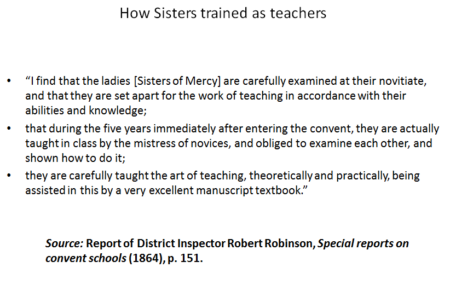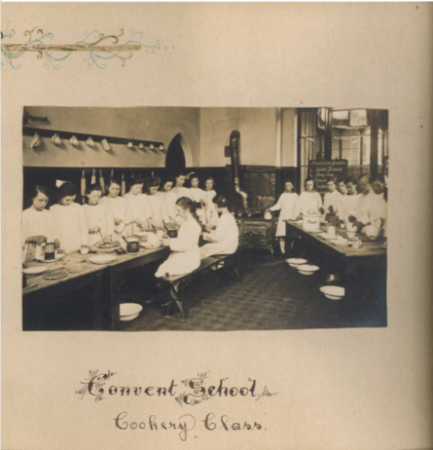Sisters of Mercy and the Evolution of Teacher Training in 19th Century Ireland
From its foundation in 1831, education was one of the primary ministries of the Sisters of Mercy. In tandem with teaching, was an involvement with teacher training, initially within the classroom under the monitorial system and from 1877, in its training colleges, Sedes Sapientiae in Baggot Street, Carysfort, Dublin and Mary Immaculate, Limerick.

The monitorial system was in extensive use in primary education in Ireland throughout much of the nineteenth century. It was introduced by the Kildare Place Society who adopted a model developed by Joseph Lancaster, a London schoolmaster. Older promising pupils were selected by teachers to assist in the classroom and develop teaching skills. It was seen as an economical way of making primary education more accessible and educating greater numbers of children without a commensurate increase in adult teachers. Baggot Street convent school began to train monitresses using a modified form of the Lancasterian system from the 1830s. These monitresses provided support in large classes, and when trained, could find positions as governesses or teachers in other schools. Catherine McAuley was familiar with the system and encouraged the superior in the Mercy convent in Tullamore, Co Offaly ‘to try and get a well qualified monitress from the model school until your Sisters know the method … She should be paid a small salary out of what the Board allows”.
By 1836 it seems that a form of teacher training was in place in Baggot Street. A schoolmistress from Newry applied to the convent for an assistant for her school “with the hope of obtaining a young woman well qualified for such a situation”.
The monitorial system became widespread throughout Mercy convent schools. Shortly after their arrival in Kinsale in 1844, the Sisters note “The foundation stone of the new poor school was laid. While the schools are being built the Sisters attend the National School for some hours daily to train monitors as well as to prepare the children for sacraments, without however being responsible for or taking charge of this school”.
 Students in the Convent of Mercy School, Thomastown, Co Kilkenny
Students in the Convent of Mercy School, Thomastown, Co Kilkenny
The National Board of Education extended the scheme of paid monitors from 1846, allowing able girls aged between fourteen and sixteen to train and receive a modest salary. Many schools had a combination of paid and unpaid monitresses.
The annalist of St Mary’s, Limerick noted in 1849 “The morning classes were taught consecutively for an hour and a half. They formed the classes which supplied the monitresses to the juniors during the greater part of the rest of the day. The monitresses were a fine set of girls with a creditable knowledge of grammar, geography, etc. and had an intelligent manner of answering on the subject matter. Their style of reading was both expressive and natural”
The Kinsale annals recorded in 1863 “four of our paid monitors went to Cork for the annual examination usually held in the schools attached to the Convent of Sisters of Mercy Saint Mary’s of the Isle. The answering of the girls was good”. Later that year, the school inspector visited and took the names of ten children selected for appointment as paid monitresses.
The 1864 Commissioners of National Education Special Reports on Convent Schools noted that Navan Mercy convent school had three paid monitresses, and ‘a class of twelve unpaid voluntary monitors, six of whom get five shillings a quarter as encouragement from the nuns’.
The monitresses in Nenagh convent school wore uniforms: blue capes, white aprons and ribboned caps. Monitresses in the Mercy national school on Hamilton Street in Belfast had three hours of daily instruction and the rest of their school day was given to teaching practice.
In Kinsale, monitresses were appointed as pupil-teachers, became governesses and took up posts as teachers in other schools. In 1878, Nora A. Cummins, a first class monitor, was appointed as assistant teacher in Drimoleague National School and to take charge of the parish choir.
The performance of monitresses was subject to annual examination and review by school inspectors. Two monitresses in Ennis Mercy school were admonished for poor results in their annual examination in 1862, and one was threatened with the withdrawal of her salary. In Kinsale in 1864 it was noted “seven of our monitors went into Cork for examination. Their answering was not satisfactory”.
St. Paul’s Mercy Convent in Belfast set up a preparatory school in the late 1860’s for girls who wanted to become monitresses but didn’t have a sufficient foundation. The school had accommodation for sixteen, with access to training in the convent national schools. In Westport, Co. Mayo, an additional classroom was added to the school in 1880 for the monitresses, where a Sister taught them reading, writing, arithmethic, book-keeping, cookery and laundry.
 Baggot Street Cooking Class
Baggot Street Cooking Class
In 1862, the Superior of Baggot Street applied to the Board of Education for pupil-teachers to be selected from among her senior monitresses. Pupil-teachers had formal links to training colleges and were better paid than classroom trained monitresses. She also applied for an increase in the number of monitresses to twenty, her present cohort of eighteen being inadequate for the instruction of 751 pupils. The Board granted her request, solidifying Baggot Street’s training role.
In 1864, the Commissioners of National Education were unable to comply with a further request from Baggot Street that “the same advantages as similar institutions in England enjoy be granted to the “training department in operation for several years past, in connection with the Baggot Street National School in which at present are instructed and trained for the office of schoolmistress and are boarded and lodged, forty young girls, while an equal number of others, who do not reside in the house are trained in the same way.”
 Mary Byrne, Rose Kelly and Sarah Hurst completed one year of training in Baggot Street and then moved to the new Carysfort Training College for the 1903 – 1904 year
Mary Byrne, Rose Kelly and Sarah Hurst completed one year of training in Baggot Street and then moved to the new Carysfort Training College for the 1903 – 1904 year
By 1877, the number of applicants for places on the Baggot Street training course was so great that the convent built a new training school. It was called Sedes Sapientiae, in honour of its patron, Our Lady Seat of Wisdom. In 1883 the school was formally recognised as a training centre for female students, under the title of Our Lady of Mercy College. The college moved to the Carysfort campus in 1903 where it remained until its closure in 1988.
Sources: Community Annals Limerick, Kinsale Ni Chearbhaill, Maire, The Contribution of the Congregation of the Sisters of Mercy to Education, Our Lady of Mercy Centenary 1877 – 1977
Marianne Cosgrave
Congregational Archivist


